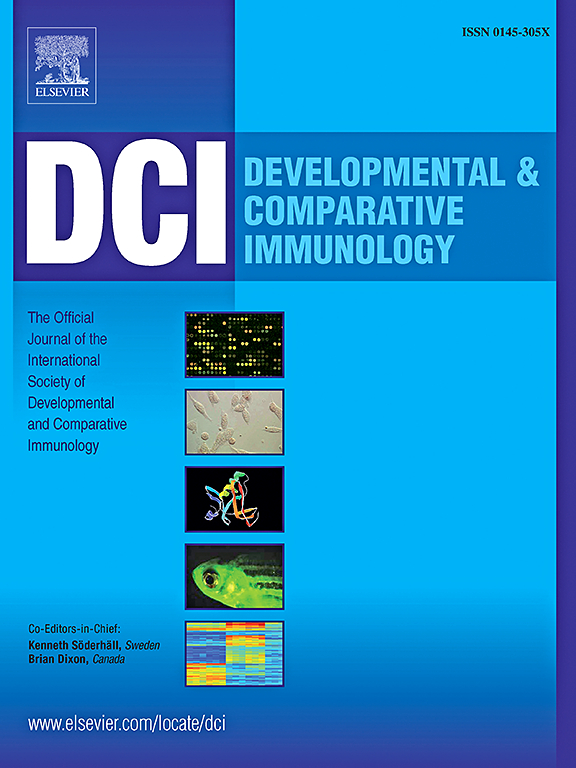Integrative analysis of the microRNA and mRNA response of barramundi (Lates calcarifer) under acute cold stress and Vibrio harveyi challenge
IF 2.7
3区 农林科学
Q1 FISHERIES
引用次数: 0
Abstract
Barramundi (Lates calcarifer) are emerging as a key species in warm-water aquaculture worldwide; however, disease outbreaks caused by Vibrio spp. are impeding industry expansion. Climate change is expected to exacerbate this issue by intensifying extreme weather events, including unusually cold temperatures, thereby increasing the risk of disease. In this study, we investigated the combined effect of cold stress and V. harveyi infection on the early transcriptome (mRNA) and microRNA responses of juvenile barramundi to enhance our understanding of host-pathogen interactions. High levels of differential gene expression were observed in fish subjected to cold stress (22 °C) post-infection with V. harveyi, with 3231 differentially expressed genes and an extensive pro-inflammatory immune response. In contrast, most differentially expressed microRNAs were associated with fish infected with V. harveyi housed under optimal temperature conditions (30 °C). MicroRNAs play a crucial role in regulating gene expression, typically through downregulation of target mRNAs. The significant upregulation of miRNAs in barramundi kept at 30 °C, and the lack of miRNA upregulation in cold stressed fish, suggests that cold stress impaired the immune-regulatory capacity of affected fish, resulting in a hyper-inflammatory response that may account for the increased mortality observed. This study is the first dual study of the transcriptome and microRNA response of barramundi to V. harveyi infection and expands understanding of the innate immune response in barramundi and the regulatory role of microRNAs in teleost fish.
barramundi (Lates calcarifer)在急性冷应激和哈维弧菌胁迫下的microRNA和mRNA响应综合分析
Barramundi (Lates calcarifer)正在成为全球暖水养殖的关键物种;然而,由弧菌引起的疾病爆发阻碍了工业的发展。预计气候变化会加剧极端天气事件,包括异常寒冷的气温,从而增加疾病的风险,从而使这一问题恶化。在这项研究中,我们研究了冷胁迫和V. harveyi感染对barramundi幼鱼早期转录组(mRNA)和microRNA反应的联合影响,以加深我们对宿主-病原体相互作用的理解。在感染哈氏弧菌(V. harveyi)后遭受冷应激(22°C)的鱼中观察到高水平的差异基因表达,有3231个差异基因表达和广泛的促炎免疫反应。相比之下,大多数差异表达的microrna与在最佳温度条件下(30°C)饲养的哈维氏弧菌感染的鱼有关。MicroRNAs在调节基因表达中起着至关重要的作用,通常通过下调靶mrna来实现。保存在30°C下的barramundi的miRNA显著上调,而冷应激鱼的miRNA缺乏上调,表明冷应激损害了受影响鱼类的免疫调节能力,导致高炎症反应,这可能是观察到的死亡率增加的原因。本研究首次对barramundi对V. harveyi感染的转录组和microRNA反应进行了双重研究,扩大了对barramundi先天免疫反应和microRNA在硬骨鱼中的调节作用的理解。
本文章由计算机程序翻译,如有差异,请以英文原文为准。
求助全文
约1分钟内获得全文
求助全文
来源期刊
CiteScore
6.20
自引率
6.90%
发文量
206
审稿时长
49 days
期刊介绍:
Developmental and Comparative Immunology (DCI) is an international journal that publishes articles describing original research in all areas of immunology, including comparative aspects of immunity and the evolution and development of the immune system. Manuscripts describing studies of immune systems in both vertebrates and invertebrates are welcome. All levels of immunological investigations are appropriate: organismal, cellular, biochemical and molecular genetics, extending to such fields as aging of the immune system, interaction between the immune and neuroendocrine system and intestinal immunity.

 求助内容:
求助内容: 应助结果提醒方式:
应助结果提醒方式:


